香港朗文二年级下册第一课
香港朗文英语二年级下Unit 1 Fast food
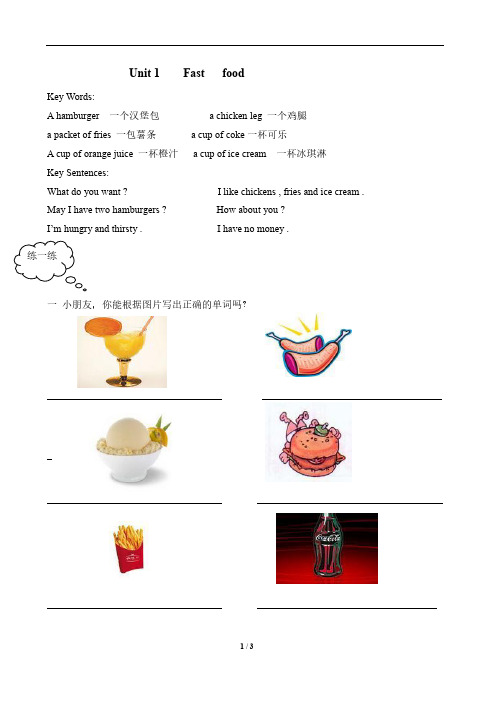
Unit 1 Fast foodKey Words:A hamburger 一个汉堡包 a chicken leg 一个鸡腿a packet of fries 一包薯条 a cup of coke一杯可乐A cup of orange juice 一杯橙汁 a cup of ice cream 一杯冰琪淋Key Sentences:What do you want ? I like chickens , fries and ice cream . May I have two hamburgers ? How about you ?I’m hungry and thirsty . I have no money .一小朋友,你能根据图片写出正确的单词吗?二小小翻译家,请把下列短语或句子汉译英!1.五个汉堡包2.两杯冰淇淋3.七包署条4.八个鸡腿5.三杯橘子汁6.六杯可乐7.没有钱8.我能帮你吗?9.我喜欢署条和冰淇淋。
10.我很抱歉!三快来比一比,赛一赛,看谁又快又准!【】1、There _______ two packets of fries.A、amB、isC、areD、/【】2、I______ hungry and thirsty,too.A、areB、isC、amD、/【】3、I don’t _____ hamburgers.A、likesB、likeC、likedD、liking 【】4、I have no money.___ I have no money,_____ .A、tooB、alsoC、eitherD、/【】5、What do you______ ?A、wantsB、wantingC、wantD、wanted每个人的生日树 Birthday TreeDecember 23 to January 1 ........... Apple Tree(苹果树)January 2 to January 11 .............. Fir Tree(冷杉、杉木) January 12 to January 24 ............ Elm Tree(榆树)January 25 to February 3 .............Cypress Tree(柏树)February 4 to February 8 ............. Poplar Tree(白杨)February 9 to February 18 ............Cedar Tree(雪松)February 19 to February 28 .......... Pine Tree(松树)March 1 to March 10 .............. .....Weeping Willow Tree(垂柳) March 11 to March 20 ............. .....Lime Tree(欧椴树、酸橙树) March 21 ......................... ...... ...Oak Tree(橡树)March 22 to March 31 ............. .....Hazelnut Tree(榛树) April 1 to April 10 .............. ...... ...Rowan Tree(花楸树) April 11 to April 20 ............. ...... ..Maple Tree(枫树)。
2年级朗文小学英语2B unit1 第一课
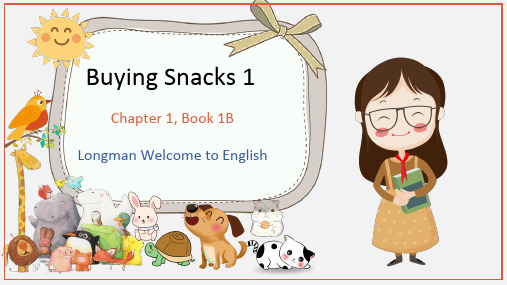
What does he like? He likes__f_is_h_ .
What does she like?
She likes __p_ot_a_to_c_h_ip_s .
What does Chocolate like?
Chocolate likes _r_a_isi_ns_.
What does Johnny like?
Buying Snacks 1
Chapter 1, Book 1B Longman Welcome to English
学习目标
1.能够识别不同零食的名称: sour plum, lemon sweets, sweets, chilli fish, potato chips, raisins…
2.学会问和回答喜欢吃什么零食 What does… like? He/She ikes…
看图填空
I he she like likes
1. __I ___ ____li_k_e__ chilli fish.
2.__S_h_e_ ___li_k_e_s potato chips 3. __H_e__ __l_ik_e_s__lemon sweets.
see you!
Johnny likes lemon sweets and sour plums.
What does Sally like?
She likes __c_h_illi_f_ish_.
What does Spencer like?
He likes potato chips and sour plums.
A He likes raisins. B She likes raisins.
( )3. Tom and Sally lemon sweets.
香港朗文3A-chapter
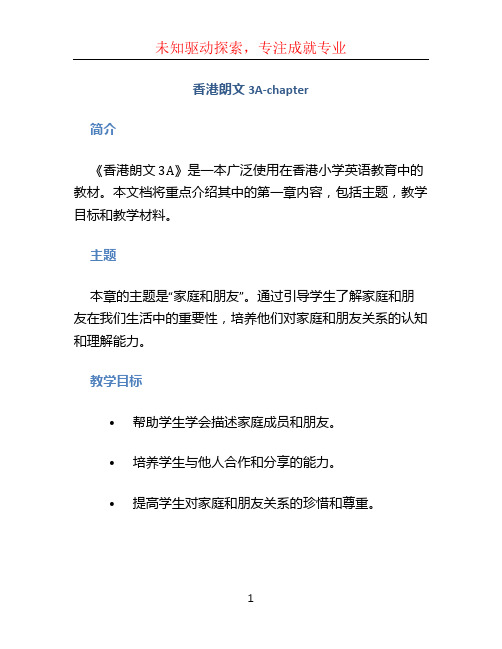
香港朗文3A-chapter简介《香港朗文3A》是一本广泛使用在香港小学英语教育中的教材。
本文档将重点介绍其中的第一章内容,包括主题,教学目标和教学材料。
主题本章的主题是“家庭和朋友”。
通过引导学生了解家庭和朋友在我们生活中的重要性,培养他们对家庭和朋友关系的认知和理解能力。
教学目标•帮助学生学会描述家庭成员和朋友。
•培养学生与他人合作和分享的能力。
•提高学生对家庭和朋友关系的珍惜和尊重。
教学材料本章的教学材料包括课本和配套练习册。
课本第一课:My family(我家)这节课通过介绍“家庭成员”的概念和家庭成员的关系,帮助学生建立对家庭的认知。
教学内容:1.通过幻灯片展示不同家庭的照片,引导学生讨论家庭成员和家庭成员之间的关系。
2.教师以个人的家庭为例,介绍家庭成员,并让学生描述自己的家庭成员。
3.学生使用课本中提供的图片和词汇,描述自己的家庭成员。
•学会描述家庭成员的外貌特征(年龄、身高、体格等)。
•学会描述家庭成员之间的关系(父母、兄弟姐妹等)。
第二课:My friends(我的朋友)这节课通过介绍“朋友”的概念和朋友之间的互动,帮助学生理解友谊的重要性。
教学内容:1.鼓励学生用英语介绍自己的朋友。
2.分组讨论并展示一位自己的朋友,并介绍他们之间的共同兴趣和活动。
3.学生完成配套练习册上的作业,描述自己的朋友。
•学会用简单的英语介绍朋友的基本信息(姓名、年龄、爱好等)。
•学会描述朋友之间的共同兴趣和活动。
总结通过本章的学习,学生将能够更好地了解家庭和朋友在我们生活中的重要性,培养他们与他人合作和分享的能力,以及提高他们对家庭和朋友关系的珍惜和尊重。
教师可以根据学生的实际情况,采用不同的教学方法和教学资源,以达到最佳的教学效果。
注意:本文档为示例文档,实际的《香港朗文3A》教材内容可能有所不同,请根据实际情况进行调整。
香港朗文二年级下册
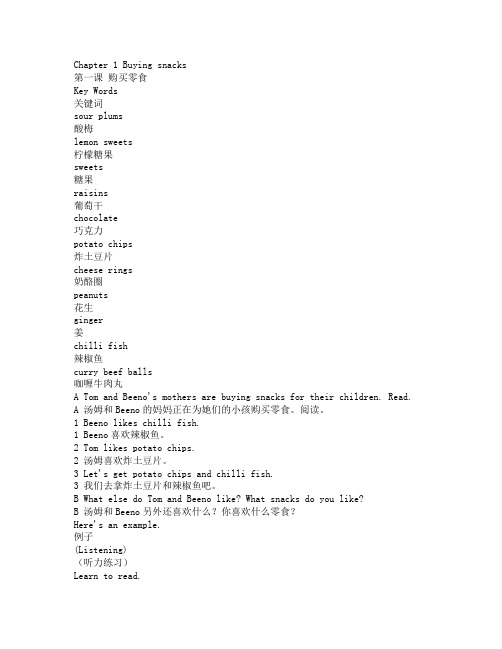
Chapter 1 Buying snacks第一课购买零食Key Words关键词sour plums酸梅lemon sweets柠檬糖果sweets糖果raisins葡萄干chocolate巧克力potato chips炸土豆片cheese rings奶酪圈peanuts花生ginger姜chilli fish辣椒鱼curry beef balls咖喱牛肉丸A Tom and Beeno's mothers are buying snacks for their children. Read.A 汤姆和Beeno的妈妈正在为她们的小孩购买零食。
阅读。
1 Beeno likes chilli fish.1 Beeno喜欢辣椒鱼。
2 Tom likes potato chips.2 汤姆喜欢炸土豆片。
3 Let's get potato chips and chilli fish.3 我们去拿炸土豆片和辣椒鱼吧。
B What else do Tom and Beeno like? What snacks do you like?B 汤姆和Beeno另外还喜欢什么?你喜欢什么零食?Here's an example.例子(Listening)(听力练习)Learn to read.学着读。
C What snacks do the Chow family like? Read and find out.C 周一家喜欢什么零食?阅读,找出答案。
1 Charlie, Cherry and their mother are in the supermarket.1 查理和查瑞还有他们的妈妈正在超级市场里面。
The children want some snacks. Charlie likes lemon sweets but Cherry does not like them.小朋友们想要一些零食。
人教版新起点小学英语二年级下册Unit1 Lesson1课件

play football fly a kite ride a bike
swim make a model plane make a snowman
Let's chant
• Bill can play football. • Me too, me too. • Yaoyao can fly a kite. • Me too, me too. • Joy can ride a bike. • Me too, me too. • Binbin can swim. • Me too, me too. • Andy can make a model plane. • Me too, me too. • Lily can make a snowman. • Me too, me too.
Let’s do
• 学生听短语,并出示相应卡片。 • 学生听短语,根据听到的顺序将短语卡片
排序。 • 教师说序号,学生说出相应的短语。 • 教师示范后,学生结对开展活动。
Homework
数阅
学读
使使
人人
精充
细实
;;
博会
物谈
使使
人人
深敏
沉捷
;;
You made my day!
伦 理 使 人 庄 重 ; 逻 辑 与 修 辞 使 人 善 辩 。
Unit 1 Playtime
Le球
play football
踢足球
kite
风筝
fly a kite
放风筝
bike
自行车
ride a bike
骑自行车
make a model plane
做飞机模型
swim
游泳
人教版二年级英语下册lesson1教学设计和反思
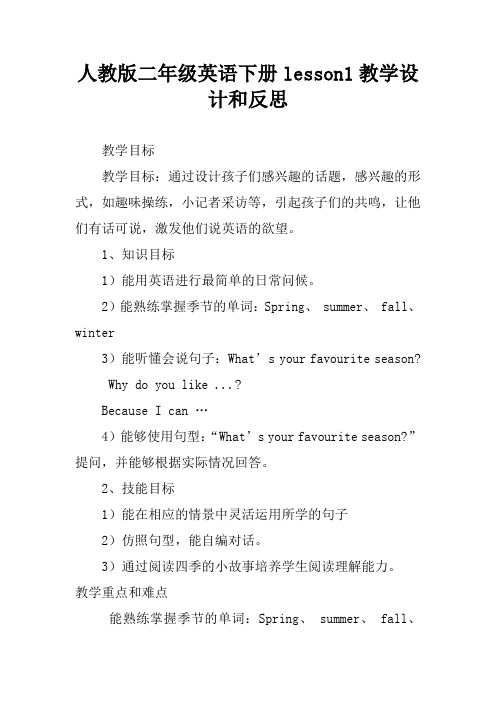
人教版二年级英语下册lesson1教学设
计和反思
教学目标
教学目标:通过设计孩子们感兴趣的话题,感兴趣的形式,如趣味操练,小记者采访等,引起孩子们的共鸣,让他们有话可说,激发他们说英语的欲望。
1、知识目标
1)能用英语进行最简单的日常问候。
2)能熟练掌握季节的单词:Spring、 summer、 fall、winter
3)能听懂会说句子:What’s your favourite season?
Why do you like ...?
Because I can …
4)能够使用句型:“What’s your favourite season?”提问,并能够根据实际情况回答。
2、技能目标
1)能在相应的情景中灵活运用所学的句子
2)仿照句型,能自编对话。
3)通过阅读四季的小故事培养学生阅读理解能力。
教学重点和难点
能熟练掌握季节的单词:Spring、 summer、 fall、
winter
3)能听懂会说句子:What’s your favourite season?
Why do you like ...?
Because I can …。
二年级英语下册 Unit 1 Lesson 1 My school(2)教案
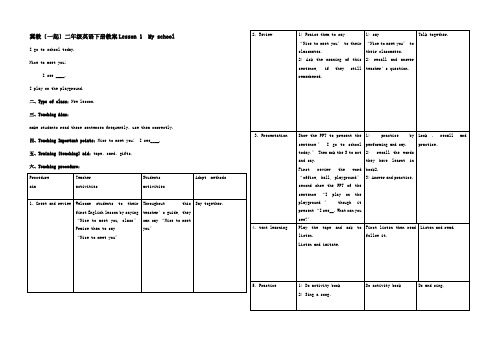
3) Answer and practice.
Look、recall and practice。
4. text learning
Playthe tape and ask to listen.
Listen and imitate.
Make a map like P3
make
七、Teaching consideration.
冀教〔一起〕二年级英语下册教案Lesson 1 My school
Igo to school today.
Nice to meetyou!
Isee ____.
Iplay on the playground.
二、Type of class:New lesson.
三、Teaching Aims:
make students read these sentences frequently,use them correctly.
First listen then read follow it.
Listen and read.
5. Practice
1) Do activity book
ቤተ መጻሕፍቲ ባይዱ2) Sing a song。
Do activity book
Do and sing.
6. home work
Make a map like P3
First review the word“office, hall, playground〞second show the PPT of thesentence“Iplay on theplayground〞though it present“Isee__.What can you see?〞
二年级下册英语第一课翻译中文
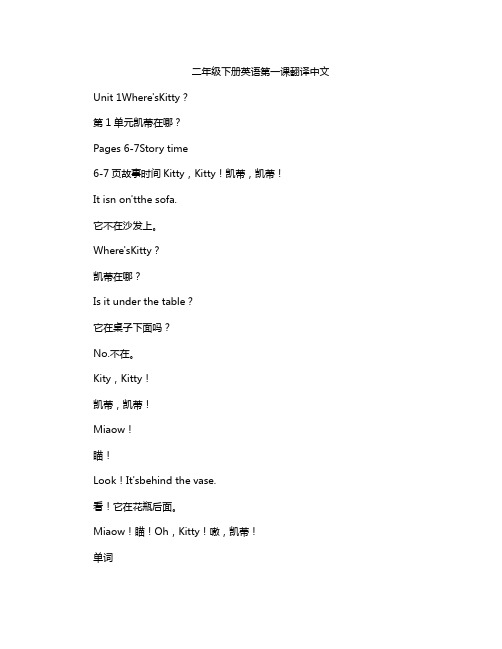
二年级下册英语第一课翻译中文Unit 1Where'sKitty?
第1单元凯蒂在哪?
Pages 6-7Story time
6-7页故事时间Kitty,Kitty!凯蒂,凯蒂!
It isn on'tthe sofa.
它不在沙发上。
Where'sKitty?
凯蒂在哪?
Is it under the table?
它在桌子下面吗?
No.不在。
Kity,Kitty!
凯蒂,凯蒂!
Miaow!
瞄!
Look!It'sbehind the vase.
看!它在花瓶后面。
Miaow!瞄!Oh,Kitty!嗷,凯蒂!
单词
on在.?上面under在.?下面
behind在.?后面in在.?里面
a sofa 一个沙发a vase一个花瓶
a basket一个篮子P9 Rhyme time音律时间Molly the cat. 小猫茉莉Molly the cat小猫茉莉
Is in the living room?
它在卧室里吗?It’sonthe mat,它在地毯上。
Playing with a broom.
在和扫把玩耍。
Word lists Unit 1
on在?上面面sofa
沙发under在.?下
面
Miaow(猫叫声)
喵
behind在.?后面
vase 花瓶basket
篮子。
二年级下英语教案-Unit 1 My school_深港朗文版
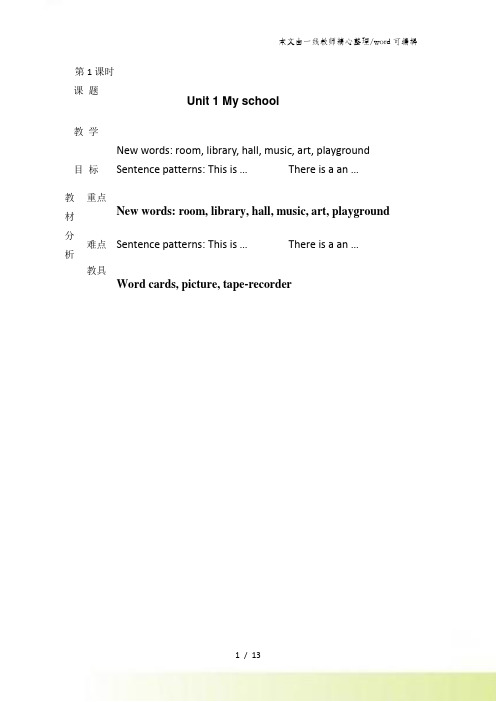
第1课时课题Unit 1 My school 教学目标New words: room, library, hall, music, art, playground Sentence patterns: This is …There is a an …教材分析重点New words: room, library, hall, music, art, playground 难点Sentence patterns: This is …There is a an …教具Word cards, picture, tape-recorder教学过程I. Free talkⅡ. Presentation1.Bring in a picture of a school and photos or pictures of thedifferent rooms taught in the Unit.2.( Books closed ) Show the picture of you the school, sayingThis is my school. Give individual pupils the picture and ask them to repeat the sentence.3.Show the pictures of the different rooms in the school. Saytheir names and ask the pupils to repeat them after me Then practise by showing a room and asking the pupils to tell me the name.4.Choose a picture and point to something in the picture thepupils know, e. g. a tree, a well-known room and say There’s a/an …Show the picture to individual pupils and ask them to point to the object and repeat the sentence. Point to other known items in the picture and encourage them to make sentences about them.5.Play the Pupil’s Book Cassette and point to the speechbubble. Ask the pupils to repeat after the beeps.Ⅲ. Practice1.( Books open ) Show Transparency. Point to the places in theschool on the page, saying There’s a classroom, etc.Encourage the pupils to repeat the sentences after you.2.Introduce the new character, Mike. Explain that Tim isshowing Mike a picture of his school. Teach the pupils the name of the school ( No. 1 Primary School ).教学过程3.Read Tim’s speech bubble. Get the pupils to point to thecorrect places. Make sentences about the other places using There’s a/an …4.Encourage the pupils to make sentences by using there is a/an…while I point to the places in the picture.5.Get the pupils to look at each of the rooms. Point at anobject in a room and say There’s a …布置作业1.Copybook 12.Workbook 13. Write the newwords on thenotebook.板书设计Unit 1 My schoolwords(picture cards)This is my school.There’s an art room.There’s a library.教学后记1.Teaching new words with motions impresses pupils.ing ‘a’ and ‘an’ should be emphasized.3. Pupils feel hard in pronouncing the words library, hall, and playground.第2课时课题Unit 1 My school教学目标New words: art room, music room, hall, library …Sentence patterns: Welcome to …Is there a …Yes, there is./ No, there isn’t.New words: art room, music room, hall, library…Sentences: Is there a … Yes, there is. / No, there isn’t.Word cards, picture, tape-recorderⅠ. Free talkⅡ. PresentationMake a plan of your school with the places marked on it.The plan does not need to have the English names written on it.( Books closed ) Show the pupils a plan of your school with the places marked on it, revising the English names for the places.Point to the plan and ask, for example, Is there a music room? Ask a pupil to come out and point to the place named and say Yes, there is. Ask about a place not in the school, e.g. Is there a swimming pool? Is there a zoo? Then teach No, there isn’t.4. ( Books open ) Show Transparency. Play the Pupil’sBook Cassette and ask the pupils to repeat the characters’ words after the beeps.Ⅲ. Practice1.Show Transparency and play the Pupil’s Book Cassette.Explain that Tim and Pat are visiting Mike’s school. The Ss listen and follow in their books. Continue to play the cassette and ask the pupils to repeat.2.Show the words in Tim and Pat’s thought bubbles. Drillthe question form with the pupils by giving them the six word cues one by one and getting the pupils to ask Is there a/an …? For each place in the school.3.Show the words with ticks and crosses in Mike’sthought bubble. Explain that a tick means they should answer Yes, there is. A cross means that they should answer No, there isn’t.4.Divide the class into three groups to role-play Tim, Patand Mike. Get them to chorus the conversation following the order of the word cues in Tim and Pat’s thought bubbles.1.Copybook 22.Workbook 23.Review whatwe learnedtoday.Unit1 My schoolWelcome to my school!Is there a …Is there an …Yes, there is./No, there isn’t.1. Practice the sentence with the plans of different school,doing a survey, or drawing a plan of pupils’ ideal school may enable the lesson more interesting.2. Pupils need to be remind to add a ‘a’ in the sentence.第3课时Unit 1 My school教学目标New words: can’t coolSentence patterns: Come and have a look.Is there a/an …?Yes, there is./ No, there isn’t. Words and sentence patternsSentence patterns: Is there a/an… Yes, .../ No, … Picture cards, tape-recorderⅠ. Free talkWhat’s in your classroom?Is there a computer?Yes, there is. / No, t here isn’tWhat’s on your desk?Is there a pencil case?…Ⅱ. Presentation1.Point to the characters in the pictures and read their speechbubbles aloud. Ask the pupils to point to the speech bubbles as you read them.2.Play the Pupil’s Book Cassette for the pu pils and ask them to saythe sentences after the cassette.3.Explain that the man in the story is the school principal.4.Ask questions about what the boy can do, e. g. Can he sing ?Encourage the pupils to answer Yes, he can./ No, he can’t.5.Ask the pupils to role-play the story in groups of three and toread the characters’ speech bubbles. Some groups may like to come out to the front and act the story.6.You may use Storycards to revise sequence and language of thestory.Ⅲ. Tick ( ) or cross ( )1.Ask the pupils to read the story again. I Read the words in thespeech bubbles with the pupils.2.Demonstrate how to tick or cross the first sentence with thepupils as an example. If the pupils are not sure of the answergo back and read the story with them again until they find theanswer.3.Check answers using Transparency.Ⅳ. SummaryI can sing. I can draw.I can’t sing. I can’t draw.1.Copybook P32.Workbook P33. Review what we learned todayUnit 1 My schoolIs there an art room? Yes, there is. /No, there isn’t.I can’t swim.I can play.1.Pupils have difficulty in understanding ‘come and have a look’, so they needto be told the meaning and some situations and some practice are needed.2.Pupils have fun in reading the story imitating the record.With the guidance of the teacher, better pupils can retell the story---- feel delighted第4课时Unit 1 My school教学目标The pronunciation of “ou” in the following words: out, around, shout, playgroundsound “ou” in the words: around, shout, playgroundsound “ou” in the words: around, shout, playgroundPicture cards, tape-recorderⅠ.Free talkWhat’s in your pencil case?Is there a rubber?Is there a ruler?Yes, there is. /No, there isn’t.Are there any pencils?Yes, th ere are. /No, there aren’t.Ⅱ. Presentation ( E. say the sound and the words.)1.Play the Pupil’s Book cassette and ask the pupils to listen to thesound and the words. Point out the spelling of this sound. It is important that the pupils realize the vowel sound is spelt with two letters. Demonstrate how to make the sound and get the pupils to look a t your face while doing so. Check that the pupils are opening their mouths sufficiently and making the sound correctly.2.Say the words slowly and clearly. Check that the pupils aresaying the sound correctly.3.Point to the pictures and check that the pupils can say thewords without your model.4.Play the Pupil’s Book Cassette again. Ask the pupils to listen tothe rhyme and to tick the correct picture. Get the pupils to say the rhyme.Ⅲ. More to do. ( Workbook P.4 )1.Ask Ss to look at the first part of the page and listen to theWorkbook Cassette.2.Draw a line to the correct words according to what they hearon the tape.Tapescript and answers: ou ( mouth, playground )3. Ask Ss to look at the second part of the page. Tell them to lookat the pictures and fill in the blanks in the sentence.What’s in your school? Is there a library? Yes, there is. What’s in your school? Is there an art room? No, there isn’t.1.Copybook P42.Workbook P43. Review what we learned todayUnit 1 My school out, around, shout, playgroundgo out run aroundin the playgroundPupils feel hard to pronounce the word round and shout for they have never learned these words. So more practise is needed. Saying the rhyme with clapping hands for several times make pupils feel more interesting.第5课时Unit 1 My school教学目标Get Ss to be more familiar with the words and the sentence patterns “There be”“ Is there a/an …”“Yes, there is/No, …”Words and sentence patterns Is there a/an … Yes, ../No,.. Words and sentence patterns Is there a/an … Yes, ../No,..Word cards, pictures and tape-recorderⅠ. Free talkWhat’s in your room?Is there a big TV?Is there a computer?Is there a fan?Yes, there is. /No, there is n’t.Ⅱ. Revision1.Review the wordclassroom, library, hall, music room, art room, playground…2. Choose some students to spell the words, and choose someable students, make sentences with these words.Ⅲ. Presentation ( F. Look and do. P.5)1.Tell the pupils to work in pairs. One should be Student A andthe other one Student B. ask all the pupils who are studentA to put up their hands. Repeat with the pupils who areStudent B.2.Read the instructions on the page with the pupil. Ask themto turn to pages 60 and 61. point out the different plans Students A and B should look at. Explain that the places on the plans are the same, but the objects are in different places.3.Tell the pupils to put ticks in the correct places in the grid onpage 60 or page 61.4.Demonstrate one conversation by having one student A ask,e.g. Is there a fan? Get Student B to answer No, there isn’t.Then have Student A ask Is there a TV?Get Student B to answer Yes, there is. It’s in the classroom. Show the pupils that Student A should tick the box across from classroom and under the TV in the grid.IV. Tell them to take turns to ask and answer questions and to put ticks in their grid according to their partner’s answers.V. Summary1. Workbook P52. Review what we learned today Unit 1 My school Is there a fan? No, there isn’t.Is there a TV? Yes, there is.It’s in the classroom.第6课时Unit 1 My school教学目标Consolidate all the new words and sentence patterns of Unit 1Part G: Sing the songsThe words and sentence patterns in unit1 Sentence patterns in unit1Word cards, picture cards, tape-recorder, projectorI. Free talkWhat’s the weather li ke today?Is there a computer in the classroom?Are there any fans in the classroom?How many fans in the classroom?Ⅱ. Revision1.Review the new wordsart room, library, hall, music room, playground, classroom, computer room, music room, around, shout2. Review sentence patterns.This is my school. There’s an art room. There’s a library.Welcome to my school!Is there a library?Yes, there is./ No, there isn’t.Ⅲ. Sing and play1.Play the Pupil’s Book Cassette for the pupils to listento the song.2.Play the cassette again and tell the pupils to tick thecorrect pictures for the rooms in the first two versesof the song.3.Play the cassette again and encourage the pupils tojoin in with the words. Then point to one of therooms shown at the bottom of the page and ask thepupils to sing the next three verses substituting thename of the room I point to.Ⅳ. Workbook. (P5)1. Ask the pupils to read the speech bubbles in thepictures on the left.2. Then match them to the pictures on the right bywriting the correct letter in the circle.Ⅴ. Summary1.Read partA and partB together.2.Sing the songs again.1.Review the words and Part A,B,C,D,E,F.2.Prepare Unit 2Unit 1 My school There is an art roomIn my school,In my school, There’s an art room in …My sc hool’s cool.。
人教版小学二年级语文下册课文全文

人教版小学二年级语文下册课文全文《人教版小学二年级语文下册》课文全文:第一课《小兔的新家》。
小兔的新家。
小兔有一个新家了,它很高兴。
新家有一张小床,一张小桌子,一把小椅子,还有一只小杯子、一只小碗、一把小勺子。
小兔的新家还有一盏小灯,还有一把小雨伞。
小兔的新家是一个小木屋,它的房子是红色的,房顶是蓝色的。
小兔的新家是在一片绿色的小树林里,小树林里有很多小花和小草。
小兔的新家真漂亮!第二课《小鱼的家》。
小鱼的家。
小鱼有一个新家了,它很高兴。
小鱼的新家是一片水草丛,水草丛里有很多小鱼。
小鱼的新家真漂亮!第三课《小鸟的家》。
小鸟的家。
小鸟有一个新家了,它很高兴。
小鸟的新家是一片绿树林,树林里有很多小鸟。
小鸟的新家真漂亮!第四课《小猫的家》。
小猫的家。
小猫有一个新家了,它很高兴。
小猫的新家是一家小商店,商店里有很多小老鼠。
小猫的新家真漂亮!第五课《小狗的家》。
小狗的家。
小狗有一个新家了,它很高兴。
小狗的新家是一片大草坪,草坪上有很多小狗。
小狗的新家真漂亮!第六课《小熊的家》。
小熊的家。
小熊有一个新家了,它很高兴。
小熊的新家是一个小山洞,山洞里有很多小熊。
小熊的新家真漂亮!第七课《小鸭的家》。
小鸭的家。
小鸭有一个新家了,它很高兴。
小鸭的新家是一片湖泊,湖泊里有很多小鸭。
小鸭的新家真漂亮!第八课《小鹿的家》。
小鹿的家。
小鹿有一个新家了,它很高兴。
小鹿的新家是一片森林,森林里有很多小鹿。
小鹿的新家真漂亮!第九课《小猪的家》。
小猪的家。
小猪有一个新家了,它很高兴。
小猪的新家是一个小农场,农场里有很多小猪。
小猪的新家真漂亮!第十课《小马的家》。
小马的家。
小马的新家真漂亮!第十一课《小羊的家》。
小羊的家。
小羊有一个新家了,它很高兴。
小羊的新家是一个小农庄,农庄里有很多小羊。
小羊的新家真漂亮!第十二课《小鸡的家》。
小鸡的家。
小鸡有一个新家了,它很高兴。
小鸡的新家是一个小鸡窝,鸡窝里有很多小鸡。
小鸡的新家真漂亮!第十三课《小鸽子的家》。
人教版小学英语一年级起点二年级下册 lesson 1(q)
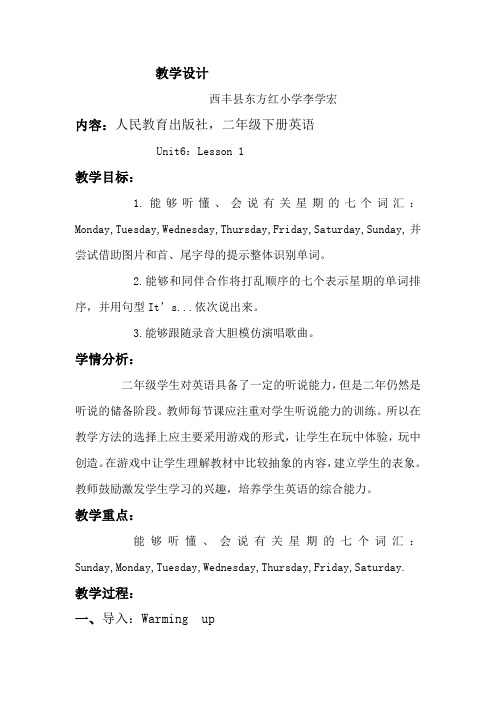
教学设计西丰县东方红小学李学宏内容:人民教育出版社,二年级下册英语Unit6:Lesson 1教学目标:1.能够听懂、会说有关星期的七个词汇:Monday,Tuesday,Wednesday,Thursday,Friday,Saturday,Sunday,并尝试借助图片和首、尾字母的提示整体识别单词。
2.能够和同伴合作将打乱顺序的七个表示星期的单词排序,并用句型It’s...依次说出来。
3.能够跟随录音大胆模仿演唱歌曲。
学情分析:二年级学生对英语具备了一定的听说能力,但是二年仍然是听说的储备阶段。
教师每节课应注重对学生听说能力的训练。
所以在教学方法的选择上应主要采用游戏的形式,让学生在玩中体验,玩中创造。
在游戏中让学生理解教材中比较抽象的内容,建立学生的表象。
教师鼓励激发学生学习的兴趣,培养学生英语的综合能力。
教学重点:能够听懂、会说有关星期的七个词汇:Sunday,Monday,Tuesday,Wednesday,Thursday,Friday,Saturday. 教学过程:一、导入:Warming up1.Greeting with the students.2.Free talk with the students.二、讲授:Learning.1.Show a calendar2.Intronuce what is the first day of a week in China and wester countries.3.Show Unit6 My Week4.Let’s listen a song5.Learnwords:Sunday,Monday,Tuesday,Wednesday,Thursday, Friday,Saturday.三、练习 Practise1.Let’s play games.A. Say quickly.B. Sort the wordsC. Guess games.2.Let’s sing a song四、小结 Sum up五、作业:Homework1.Read the words.2.Practice the drills:It’s…六、Let’s chant.。
Chapter1 Helping at home(课件)新版香港朗文英语二年级下册
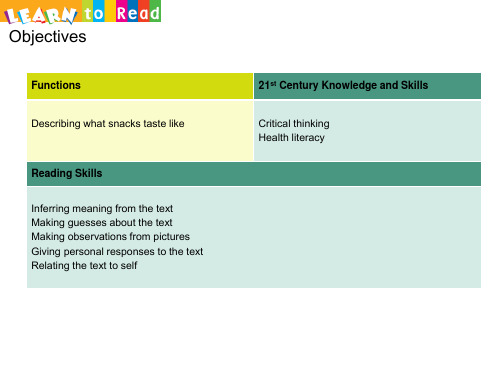
Second reading
Let’s watch the video and read the story again!
Activity 1
Answers
Post-reading
Let’s do some more activities!
Activity 2
Activity 34
Who says these words in the story?
Activity 34
Who says these words in the story?
Can I have some chocolate …?
Activity 4
Spin and say!
Start
Stop: press ‘1’
Chilli
sauce
Re-start: press ‘~’
Objectives
Functions
Describing what snacks taste like
Reading Skills
Inferring meaning from the text Making guesses about the text Making observations from pictures Giving personal responses to the text Relating the text to self
Are chocolate and lemon sweets good for you?
Shared reading
What are Charlie and Cherry doing?
Do you think Dad wants some lemon sweets too?
- 1、下载文档前请自行甄别文档内容的完整性,平台不提供额外的编辑、内容补充、找答案等附加服务。
- 2、"仅部分预览"的文档,不可在线预览部分如存在完整性等问题,可反馈申请退款(可完整预览的文档不适用该条件!)。
- 3、如文档侵犯您的权益,请联系客服反馈,我们会尽快为您处理(人工客服工作时间:9:00-18:30)。
Here's an example.
例子
(Listening)
(听力练习)
Learn to read.
学着读。
C What snacks do the Chow family like? Read and find out.
C 周一家喜欢什么零食?阅读,找出答案。
比利和波波喜欢其他的零食吗?聆听,打勾或打叉。
(Listening)
(听力练习)
Task
作业
Do a survey of the snacks your friends like and do not like. Tell the teacher the results.
做一个关于你的朋友喜欢和不喜欢的零食的调查。把结果告诉老师。
你们喜欢什么?
I like hot dogs.
我喜欢热狗。
I like hot dogs and hamburgers.
我喜欢热狗和汉堡包。
I like hot dogs, hamburgers and cookies.
我喜欢热狗,汉堡包和饼干。
Now you try.
现在你来试。
1 Charlie, Cherry and their mother are in the supermarket.
1 查理和查瑞还有他们的妈妈正在超级市场里面。
The children want some snacks. Charlie likes lemon sweets but Cherry does not like them.
查理,就寝时间不可以吃糖果。它们对你的牙齿不好。
6 Can I have some lemon sweets, Charlie?
6 查理,我可以吃一些柠檬糖果吗?
Can Dad eat some lemon sweets now? why?
爸爸现在可以吃一些柠檬糖果吗?为什么?
7 Yes, you can. It isn't your bedtime yet.
妈妈,我可以要一些巧克力吗?它们很甜。
2 Ok. Here you are, Cherry. Don't eat too much.
2 好的,给你,查瑞。不可以吃太多。
3 Here you are, Charlie. Don't eat too many, only two a day.
3 查理,给你。不可以吃太多,一天只能吃两颗。
小朋友们想要一些零食。查理喜欢柠檬糖果,但是查瑞不喜欢它们。
She thinks they are too sour.
她认为柠檬太酸了。
May I have some lemon sweets please, Mum?
妈妈,我可以要一些柠檬糖果吗?
Can I have chocolate, Mum? It's sweet.
Chapter 1 Buying snacks
第一课 购买零食
Key Words
关键词
sour plums
酸梅
lemon sweets
柠檬糖果
sweets
糖果
raisins
葡萄干
chocolate
巧克力
potato chips
炸土豆片
cheese rings
奶酪圈
peanuts
花生
ginger
姜
chilli fish
Language Fun
趣味语言
F Play a memory game. Choose the things you like from the fast food shop.
F 玩一个记忆游戏。从快餐店中选出你喜欢的食物。
Here is an example
下面是些例子
What do you like?
2 Tom likes potato chips.
2 汤姆喜欢炸土豆片。
3 Let's get potato chips and chilli fish.
3 我们去拿炸土豆片和辣椒鱼吧。
B What else do Tom and Beeno like? What snacks do you like?
是的,他喜欢。他也喜欢辣椒鱼。比利喜欢辣椒鱼吗?
No, he doesn't. It's too hot. He likes cookies.
不,他不喜欢。它太辣了。他喜欢饼干。
Now you try.
现在你来试。
Do Billy and Bobo like the other snacks? Listen and put a tick or a cross.
7 是的,可以。您的就寝时间还没有到。
D Circle the correct pictures.
D 圈出正确图画。
1 How many packets of lemon sweets does Mrs Chow buy?
1 周太太买了多少包柠檬糖果?
2 Who likes lemon sweets?
2 谁喜欢柠檬糖果?
3 How many sweets a day can Charlie eat?
3 查理一天可以吃多少颗糖果?
Phonics
语音
Say the sounds and the words.
说这些发音和单词。
ch
ch
cheese
奶酪
chocolate
巧克力
j
juice
果汁
jeans
牛仔裤
Here are some examples.
这是一些例子。
Billy doesn't like peanuts. They're too salty. Does Bobo like peanuts?
比利不喜欢花生。它们太咸了。波波喜欢花生吗?
Yes, he does. He also like chilli fish. Does Billy like chilli fish?
辣椒鱼
curry beef balls
咖喱牛肉丸
A Tom and Beeno's mothers are buying snacks for their children. Read.
A 汤姆和Beeno的妈妈正在为她们的小孩购买零食。阅读。
1 Beeno likes chilli fish.
1 Beeno喜欢辣椒鱼。
Can you say these words?
你会说这些单词吗?
Cherry
查瑞
Jerry
杰瑞
Pre-task Activity
作业前活动
E Tom and Beeno are buying snacks for their brothers. Act Tom and Beeno.
E 汤姆和Beeno正在为他们的弟弟买零食。扮演Tom和Beeno。
Thanks, Mum!
谢谢您,妈妈!
4 I love lemon sweets.
4 我喜欢柠檬糖果。
Dad likes lemon sweetharlie's bedtime.
5 查理的就寝时间到了。
No sweets at bedtime, Charlie. They're not good for your teeth.
